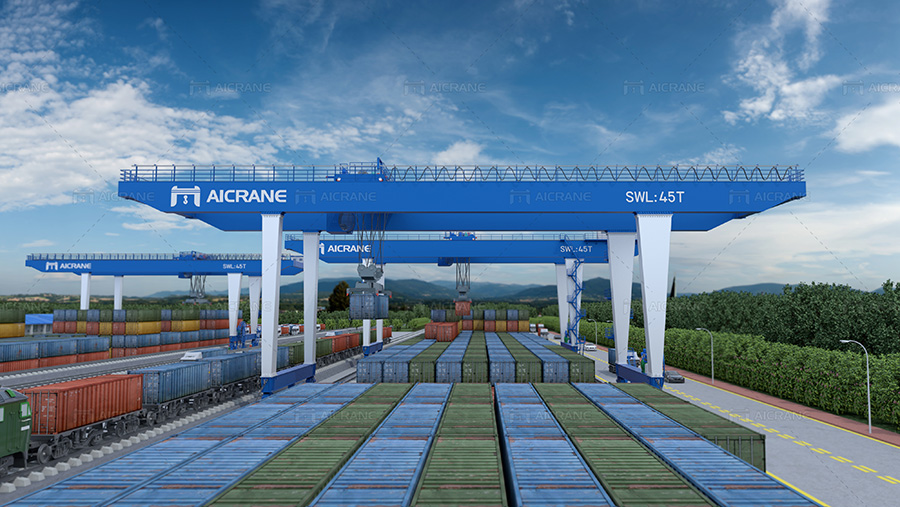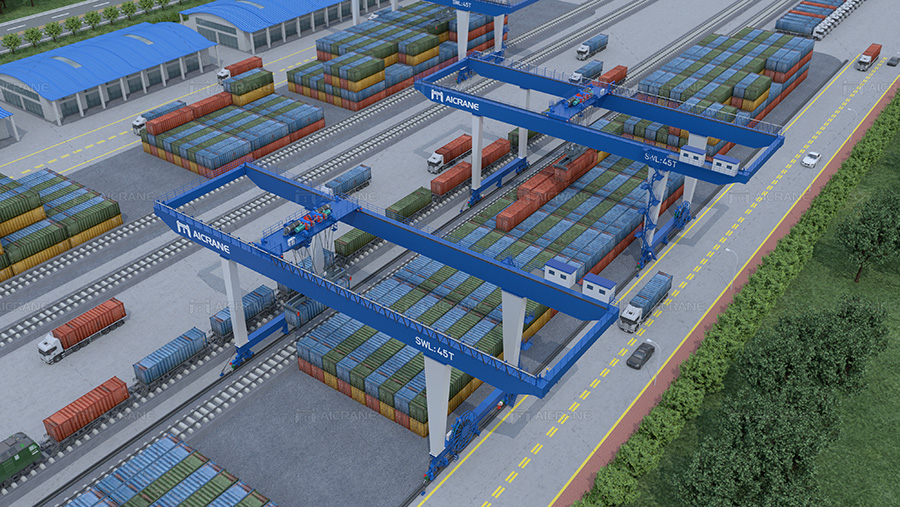Rail-mounted gantry cranes (RMG cranes) play a pivotal role in modern logistics and port operations, particularly in container handling. As the shipping industry continues to evolve, one of the most significant changes has been the increase in container sizes. This trend has placed new demands on RMG cranes, which must adapt to ensure efficient and safe operations. This article explores how rail-mounted gantry cranes for sale are evolving to handle larger containers, focusing on technological advancements, design modifications, and operational strategies.

The Growing Trend of Larger Containers
The shipping industry has seen a remarkable increase in container sizes over the past few decades. The introduction of ultra-large container vessels (ULCVs) has driven the demand for larger containers, often reaching sizes of up to 40 feet in length and beyond. These larger containers offer cost advantages in terms of shipping efficiency and economies of scale, but they also present challenges for port operations and crane systems.
Rail-mounted gantry cranes, crucial for loading and unloading containers from ships to storage areas or transport vehicles, must adapt to handle these larger dimensions. The key challenge is ensuring that the cranes can manage the increased weight and size of the containers without compromising efficiency or safety.
Technological Advancements
- Enhanced Lifting Capacities
One of the primary adaptations in RMG cranes is the increase in lifting capacities. Modern RMG cranes are equipped with more powerful hoist systems and advanced materials that allow them to handle the increased weight of larger containers. These cranes often feature upgraded motors and hydraulic systems designed to provide the necessary lifting force while maintaining stability.
- Extended Reach and Span
To accommodate the larger containers and the increasing size of container ships, RMG cranes have been designed with extended reach and span capabilities. Longer booms and wider spans enable cranes to handle wider containers and access containers located further apart. This adaptation ensures that cranes can service larger vessels and handle larger container stacks efficiently.
- Advanced Control Systems
The integration of advanced control systems is another critical adaptation. Modern RMG cranes use sophisticated software to manage lifting operations, including real-time monitoring of container positions, weight, and movement. These systems improve precision and reduce the likelihood of errors or accidents. Automated control systems can also optimize container gantry crane movements, reducing the time required for loading and unloading operations.
- Improved Stability and Safety Features
Handling larger containers requires enhanced stability and safety features. New RMG crane designs incorporate features such as advanced sway control systems to minimize container swinging during lifting and movement. Additionally, modern cranes are equipped with improved braking systems and sensors to detect and prevent potential collisions or accidents.

Design Modifications
- Structural Reinforcements
To support the increased loads from larger containers, RMG cranes are being constructed with reinforced structures. This includes stronger support beams, more robust frame designs, and reinforced rail systems. These modifications ensure that the cranes can handle the additional stress and weight without compromising their structural integrity.
- Upgraded Under Carriages and Wheels
The undercarriages and wheels of RMG cranes have also been upgraded to support the increased weight of larger containers. New designs feature heavier-duty wheels and enhanced suspension systems to distribute the load more evenly and reduce wear and tear on the rail systems. This adaptation helps maintain smooth crane operation and extends the lifespan of the equipment.
- Adjustable Spreaders
Spreaders, the devices used to lift and secure containers, have been redesigned to handle larger sizes. Adjustable spreaders can accommodate different container widths and lengths, providing greater flexibility and efficiency in container handling. Modern spreaders are also equipped with advanced locking mechanisms to ensure secure container attachment during lifting and movement.
Operational Strategies
- Optimized Container Stacking
Effective container stacking is crucial for managing larger containers. Ports and terminal operators are adopting new stacking strategies to maximize space and improve efficiency. This includes using computer algorithms to optimize container placement and reduce the time required for crane operations. By strategically stacking containers, ports can minimize the need for gantry crane repositioning and enhance overall productivity.
- Enhanced Training for Operators
With the increased complexity of handling larger containers, there is a growing emphasis on operator training. Crane operators must be skilled in using advanced control systems and managing the increased weight and size of containers. Comprehensive training programs are essential to ensure that operators can handle the new equipment and perform their tasks safely and efficiently.
- Regular Maintenance and Upgrades
To keep pace with the demands of larger containers, regular maintenance and upgrades are essential. Ports are investing in ongoing maintenance programs to ensure that RMG cranes remain in optimal condition. This includes routine inspections, component replacements, and software updates to address any wear and tear and incorporate the latest technological advancements.
- Integration with Automated Systems
The integration of RMG cranes with automated systems is becoming increasingly common. Automated container handling systems, such as automated stacking cranes and automated guided vehicles, work in tandem with RMG cranes to streamline port operations. This integration improves efficiency, reduces human error, and ensures that larger containers are handled smoothly throughout the logistics chain.
Conclusion
The adaptation of rail-mounted gantry cranes to handle increased container sizes is a testament to the evolving demands of the shipping and logistics industry. Through technological advancements, design modifications, and operational strategies, RMG cranes are meeting the challenges posed by larger containers. As container sizes continue to grow and port operations become more complex, ongoing innovation and adaptation will be essential to maintaining efficiency, safety, and productivity in the logistics sector. By embracing these changes, rail-mounted gantry cranes are poised to remain a vital component of modern port operations, facilitating the movement of goods and contributing to the global supply chain. Learn more: https://aicraneliftingsolution.com/